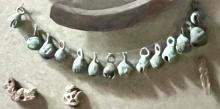coyolli (Mdz41r)
This element for bell (coyolli) has been carved from the compound sign for the place name, Xocoyoltepec. It shows two seemingly gold bells connected by a horizontal line. The bells have two horizontal stripes and a vertical slit at the bottom where the sound would escape.
Stephanie Wood
These bells seem to have been made in both gold and copper (note the color differences, below). We have several terms relating to bells in this collection. By 1560 European bells are clearly making headway into local designs. See the names deriving from the verb to ring (tzilini), below.
Stephanie Wood
c. 1541, but by 1553 at the latest
Stephanie Wood
cascabeles, campanas, campanillas, bells, pinjantes, metales, oro, gold
These copper bells are from Post-Classic Jalisco, and they are now housed in the Museo Nacional de Antropología e Historia, Sala 10. We do not know if they were called coyolli, but they have something of that look, and Jalisco had some Nahuatl speakers. Photo by S. Wood, 30 April 2025.

coyolli, a small bell, https://nahuatl.wired-humanities.org/content/coyolli
bells
el cascabel
Stephanie Wood
Codex Mendoza, folio 41 recto, https://digital.bodleian.ox.ac.uk/objects/2fea788e-2aa2-4f08-b6d9-648c00..., image 92 of 188.
The Bodleian Libraries, University of Oxford, hold the original manuscript, the MS. Arch. Selden. A. 1. This image is published here under the UK Creative Commons, “Attribution-NonCommercial-ShareAlike 3.0 License” (CC-BY-NC-SA 3.0).






